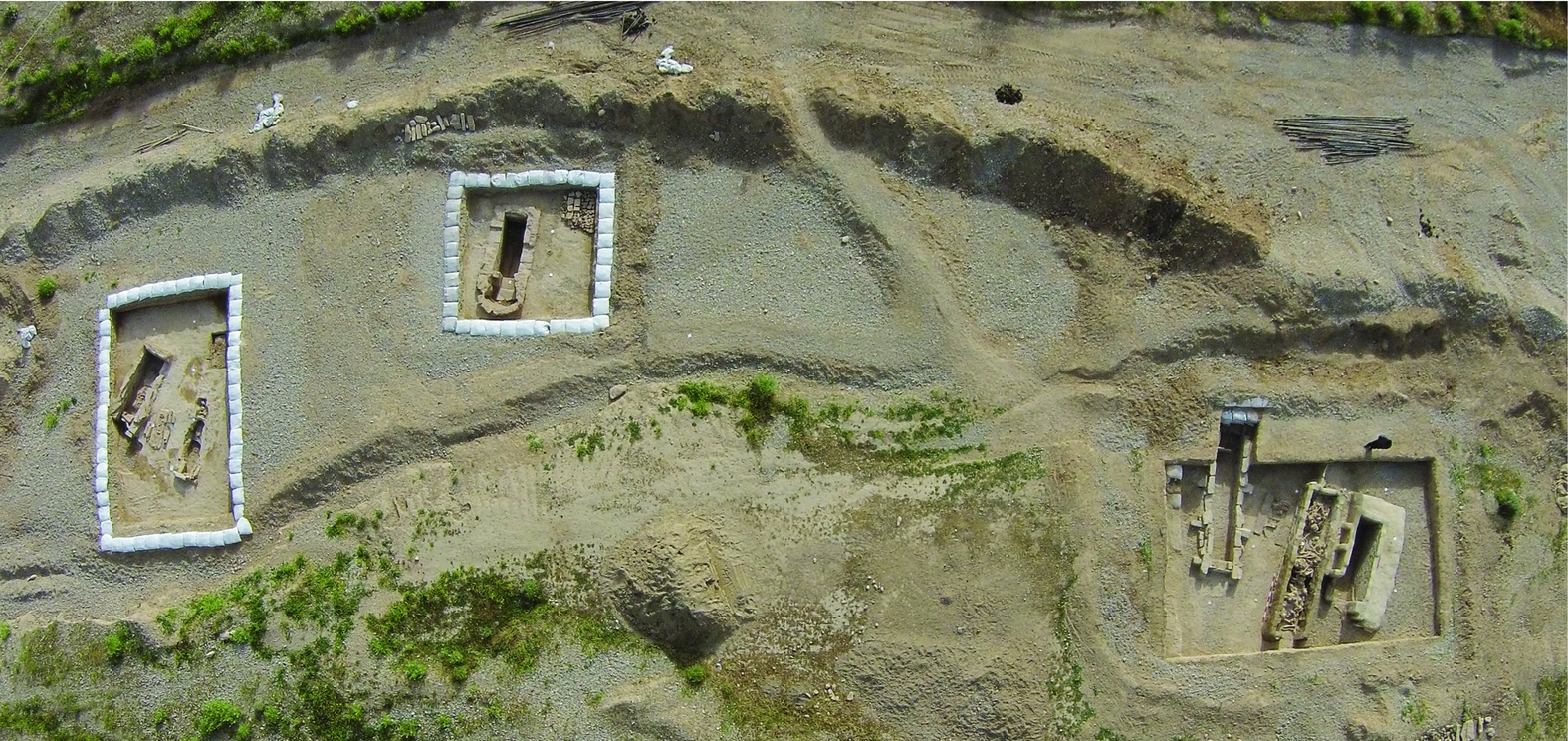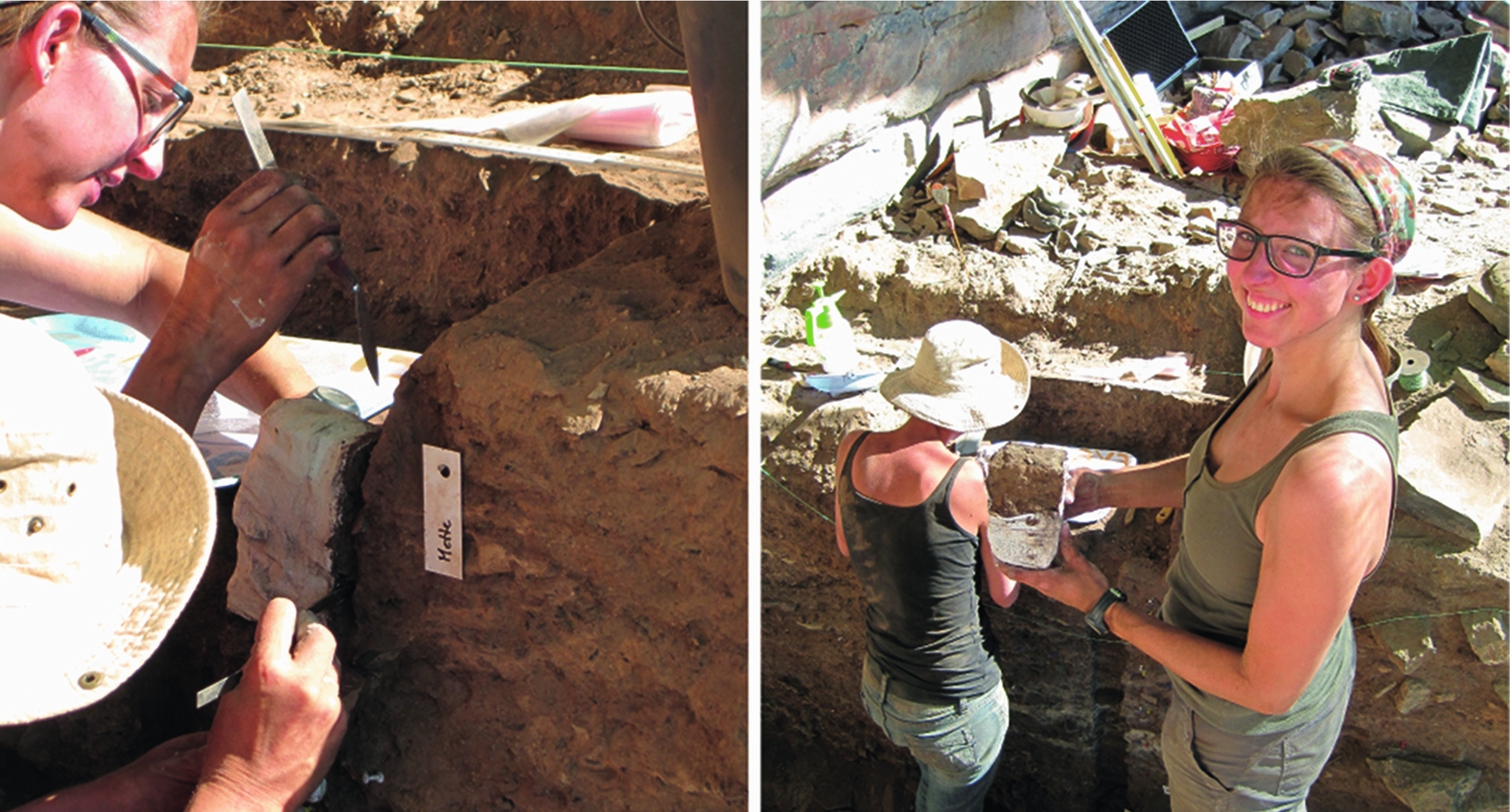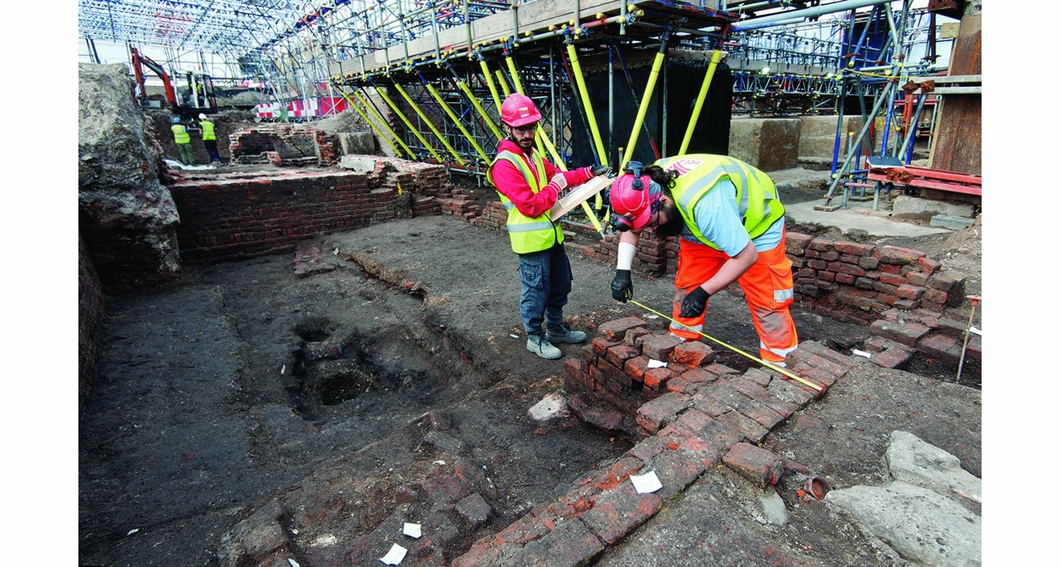
Chega Sofla cemetery in the south-east of the Susiana Plain, Iran (featured in this month's Project Gallery).

Sampling for micromorphology at the Middle Stone Age deposits of Pockenbank Rockshelter (Namibia) in an interdisciplinary geoarchaeological research programme offering new insights into human occupation history and site formation processes during the Late Pleistocene (featured in this month's Project Gallery). Left: Isabell Schmidt, project coordinator; right: Elena Hensel; photographs by Götz Ossendorf.
A little over 8000 years ago, a hundred kilometres west of Norway, a massive shelf of rock collapsed under the sea, sending a tsunami southwards. Funnelled and focused by the narrowing North Sea, the tsunami removed whatever was left of Doggerland and the land-bridge connecting Britain to the European mainland. This event, the Storegga Slide, marks the point at which Britain most recently became an island. I say ‘most recently’ as that had happened on several previous occasions when successive ice ages drove sea-levels higher and lower. Insularity does not mean isolation, of course, and connections between Britain and its neighbours continued to thrive and flourish over the millennia that followed. There was a lively maritime traffic, and Eurostar today does the journey in little more than 20 minutes. But the dividing straits, although narrow, have at times had a significant impact, sending island and mainland off in different directions or at different velocities. Early farming settlement, for example, travelled from Hungary to Brittany in around half a millennium, but then waited a thousand years or more before crossing to southern England.
At the same time, the English Channel could sometimes prove a welcome obstacle. That was so during the Napoleonic Wars when Napoléon, having defeated most of his Continental opponents, resolved to invade Britain. The British naval victory at Trafalgar in October 1805 put paid to those plans, yet archaeological traces remain, not only in the form of coastal fortifications in the south-east of England, but also of military camps around Boulogne. Camps such as those at Montreuil and Saint-Omer housed thousands of troops and placed a huge logistical demand on food and other supplies.
The excavation of one of these Boulogne camps in 2010 revealed just how much of a problem this presented in the days before modern transport infrastructure. How did this affect the local environment? Aurélie Salavert and her team (pp. 1334–47) analysed the wood charcoal from there, and compared it with official records. Wood was in demand for all kinds of needs, not least cooking and keeping warm. Three species came from official supplies—oak, hornbeam and beech—but ten other ‘unofficial’ species have also been identified in these samples. Official supplies came from managed forests, but the impact of such large military camps on the surrounding woodland clearly went far beyond that, as individual units sought to eke out their meagre allocation by drawing on other sources. Indeed, French woodland shrank to its lowest ever extent in the early nineteenth century, and the Napoleonic Wars may well have been responsible for that decline. The archaeobotany of military conflict is a theme that merits more detailed consideration. We are all familiar with the barren, treeless battlefields of the First and Second World Wars, but the incidental damage to European woodland cover will surely have been very much greater. Did all major conflicts leave recognisable signatures in the pollen record?
As a creator of modern landscapes, however, military action is dwarfed by industrialisation. The discovery of gold in Australia in 1851 rapidly led to dramatic change: miners and many others flocked to the gold workings, and rivers and streams were harnessed to process the ore, flushing the detritus downstream with the waste water. Susan Lawrence and colleagues (pp. 1348–62) have shown that the damage reached up to 60km from the mines themselves, engulfing floodplains and destroying farmland. This, perhaps, is what the Anthropocene (discussed in our June issue) looks like on the ground: not just a few mineral workings, but the transformation of entire river catchments.
World Heritage 2016
The channels that criss-cross the Australian gold workings belong to a long tradition of water control that has taxed human ingenuity since the first irrigation canals were dug in the dusty plains of Mesopotamia some 7000 years ago. The challenges became all too apparent as canals became ever longer. Precious irrigation water was lost through evaporation before it ever reached its destination, and, as early as the third millennium BC, Sumerian cuneiform texts were decrying the problems of salination as evapotranspiration left salt deposits in irrigated fields exposed to the hot Near Eastern sun. A clever, if laborious, solution was the qanat. These gravity-driven canals, developed in Iran in the early first millennium BC, carried water underground, sometimes for several kilometres, minimising loss through evaporation en route. They are one of the latest additions to the list of UNESCO World Heritage Sites.
The new additions are characteristically diverse: the medieval city of Ani in eastern Turkey, with its impressive towered wall and splendid Armenian churches; the monastic remains of Nalanda Mahavira in north-eastern India; the eighteenth-century British naval dockyards in Antigua; the Antequera megalithic tombs in southern Spain; and the basalt and coral ruins of Nan Madol in Micronesia, to name but a few. Also included is the Zuojiang Huashan Rock Art Cultural Landscape in south-west China, which was featured in our June 2015 issue. Indeed, China (land area 9.6 million km2, population 1.4 billion) now has no fewer than 50 World Heritage Sites on the UNESCO list, but still lies in second place behind Italy (0.3 million km2, population 60 million) with 51 WHS. Global heritage of ‘outstanding universal value’ remains an uneven concept.
An anniversary year
The year 2016 has been marked by a number of significant centenaries. April, for example, saw the four-hundredth anniversary of the death of William Shakespeare. That coincided with excavations by Museum of London Archaeology (MOLA) at the site of the Curtain, the Tudor playhouse north of the Thames that premiered several of Shakespeare's most famous plays (including Romeo and Juliet and Henry V) in the 1590s. These excavations follow the discovery and excavation of the Rose Theatre in 1989, and of a small portion of the more famous Globe later the same year. The Rose hit the headlines not only through its Shakespearian connections, but also due to the controversy attending its excavation and preservation (see Wainwright 1989Footnote 1 ). Development was stopped for several weeks while a solution was agreed. Fortunately, the bulk of what survived was eventually preserved beneath the modern office block that now covers the site, and it can be visited today.

Excavation of the Curtain, a Tudor playhouse in London, where many of Shakespeare's most well-known works were performed in the 1590s. © MOLA.
As MOLA archaeologist Sarah Trehy reminds us, the Curtain (along with the Globe and the Rose), is, properly speaking, a ‘playhouse’, rather than a ‘theatre’ because the central space was left open to the elements. But the Curtain differs from the others in one significant respect. The ground plan reveals its origins in the inn yards where players previously used to perform; to general surprise, it has turned out to be a rectangular structure, rather than the polygonal shape familiar from the Rose and the Globe. As with the latter, however, it had a central unroofed space surrounded by tiered galleries for the wealthier playgoers. With some walls surviving up to 1.5m in height, it is gratifying to know that (echoing the Rose before it) the remains will be preserved and accessible to visitors once the development is completed.
Another centenary this year recalls the purchase by the British Museum of the Parthenon sculptures known as the Elgin Marbles. The story is well known (St Clair 1998Footnote 2 ). Lord Elgin, British ambassador to the Ottoman Empire, secured a firman in 1801 permitting him to draw and model the sculptures, and to take away anything that did not interfere with the Turkish fortifications on the Acropolis. That firman became the basis for the removal of the Parthenon frieze and its shipment back to Britain. In June 1816, the sculptures were purchased by the British government and transferred shortly afterwards to the British Museum, where they have remained since. There was controversy about their initial acquisition, and that has scarcely abated in later years when the question of restitution—of returning the sculptures to Athens—has repeatedly been raised and debated. The Marbles were purchased by a special Act of Parliament. Recently, a new Act of Parliament has been proposed to reverse that earlier decision. There are a number of strands to the argument—that all of the Parthenon sculptures should be seen together (half of them remain in Greece), that they were illegally removed, that Greece was under foreign occupation at the time, that Elgin had no authority to dismantle a standing structure. Those opposed to their return worry that it risks opening the floodgates, or that the marbles rightfully have a key place in a museum of world culture. Inevitably, the ethics become confounded with the politics. To whom would we be restoring the sculptures? To the Greek state? To the Greek people? To the city of Athens? Or simply to the building from which they were removed? There are deeply (and honestly) held views on both sides, but opinion polls suggest that the majority of British public opinion favours restitution, if it could be amicably achieved.
Brexit and archaeology
This editorial opened with the image of Britain separated from the European mainland as Doggerland was flooded by rising sea-levels. That image has a special resonance in the current post-Brexit environment, where once again the cultural, economic, political and social ties between the UK and the rest of Europe have come under the spotlight.
There is widespread alarm in university circles that Brexit will be damaging for all parties, with reduced access to EU research funds, reduced mobility of researchers moving in both directions and a reduction in British-European research collaborations. UK archaeologists have been major beneficiaries of EU funding. The European Research Council has supported field and laboratory projects covering a diversity of themes including Star Carr, the Maltese temples, Bronze Age mobility, Saharan statehood and trade, and the African origins of the Acheulean. Furthermore, UK archaeology departments (as with those of other disciplines) have been enriched by a welcome proportion of non-UK academic staff (including from the EU) who bring international perspectives to teaching and research, and who help to keep our horizons broad.
It remains to be seen what the long-term post-Brexit arrangements will be, and most important at this stage is to do what we can to ensure that archaeology is not lost to view in the negotiations. Given the scale of the challenges ahead, however, we cannot expect to have a prominent voice. The general consensus among UK archaeologists is that Brexit will be harmful to our subject, both domestically and overseas. It is up to those of us who have spent decades working with European partners to send a very clear message that we will do our best to maintain and expand such collaborations into the future.


